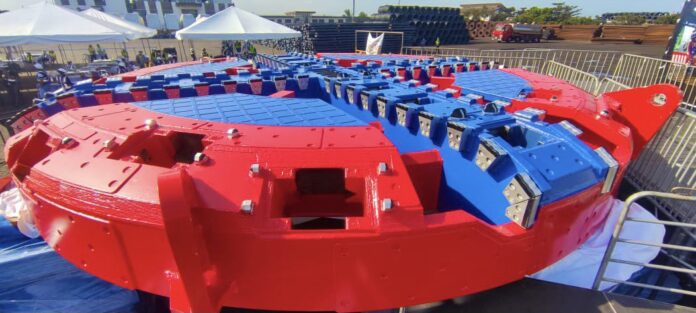
-
The cutter head of the first of six tunnel boring machines (TBMs) that will be used for partial operation of the Metro Manila Subway (MMS) project has arrived
-
In the days ahead, the remaining parts of the machine will arrive for assembly, with the TBM to undergo mandatory operational tests prior to being lowered underground for tunneling works
-
A total of 25 TBMs will be utilized to dig underground and lay out the tunnels for the MMS project
-
The 36-kilometer MMS project aims to ease traffic congestion, meet fast-rising transport demand, and reduce air pollution in the country’s premier urban center
The cutter head of a tunnel boring machine (TBM) to be used in construction of the Philippines’ first ever underground railway system has arrived.
The 74-ton cutter head, the largest part of the TBM, was unloaded at the Manila port on February 5. The cutter head will be used to break, cut and grind rocks and soil by rotating its 36-piece disc cutter, composed of 15 pieces of single roller cutters (RCs) and 21 pieces of twin RCs.
Named Kaunlaran, the tunnel boring machine is one of six TBMs to be used in the partial operability section of the Metro Manila Subway (MMS).
In the following days of the month, the remaining parts of the machine will arrive and be transported to the site for assembly and mandatory operational testing prior to being lowered underground to start tunneling works. Tunneling for the partial operability phase of the project is expected to be completed by the third quarter of this year.
A total of 25 TBMs will be utilized for the MMS project, the first underground railway system in the country that will provide the most modern mass transportation in the National Capital Region (NCR). The subway will stretch from Valenzuela City to FTI, Parañaque, and Ninoy Aquino International Airport Terminal 3 (NAIA T3) in Pasay, and will further extend across the north and south zones of the Greater Capital Region.
“To accelerate the construction of the Metro Manila Subway Project and to minimize road interference during construction, we will be using not just 1 but a fleet of 25 Japanese-made tunnel boring machines,” Department of Transportation (DOTr) undersecretary for railways Timothy John Batan said.
The TBMs will be used to dig underground and lay out the tunnels. They can excavate through a variety of ground conditions, from hard rock to sand.
In February 20, 2019, DOTr and Japanese firm Shimizu Corp. signed the contract that was awarded to the joint venture of Shimizu, Fujita Corp., Takenaka Civil Engineering Co., Ltd., and EEI Corp.
READ: Construction for Metro Manila Subway starts
The joint venture will design and build the subway’s partial operability section.
The 36-kilometer (km) subway project aims to ease traffic congestion, meet fast-rising transport demand, and reduce air pollution in the country’s premier urban center.
The first phase of the MMS project will be constructed using cutting-edge Japanese tunneling technology and a JPY104.53 billion (about P49.11 billion or US$943.34 million) loan from Japan.
The first phase will stretch from Mindanao Avenue in Quezon City to FTI in Taguig, before continuing on to NAIA.
DOTr earlier said that since Metro Manila’s weather and seismic conditions are very similar to those of Japan’s, the MMS is employing proven Japanese technologies to make the railway system resilient to natural disasters.




